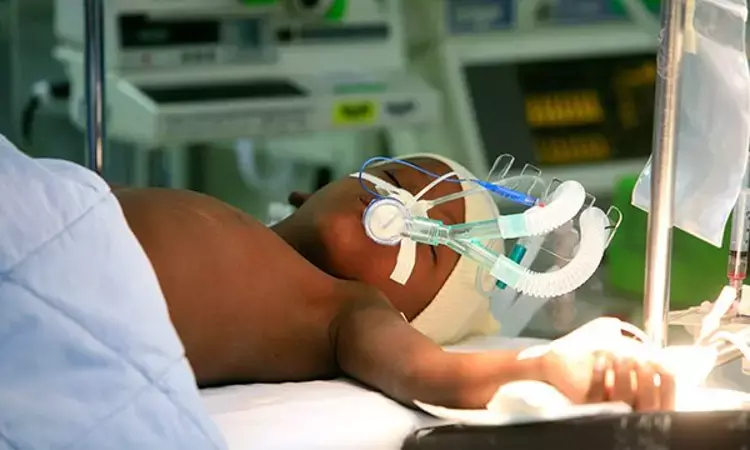- Home
- Medical news & Guidelines
- Anesthesiology
- Cardiology and CTVS
- Critical Care
- Dentistry
- Dermatology
- Diabetes and Endocrinology
- ENT
- Gastroenterology
- Medicine
- Nephrology
- Neurology
- Obstretics-Gynaecology
- Oncology
- Ophthalmology
- Orthopaedics
- Pediatrics-Neonatology
- Psychiatry
- Pulmonology
- Radiology
- Surgery
- Urology
- Laboratory Medicine
- Diet
- Nursing
- Paramedical
- Physiotherapy
- Health news
- Fact Check
- Bone Health Fact Check
- Brain Health Fact Check
- Cancer Related Fact Check
- Child Care Fact Check
- Dental and oral health fact check
- Diabetes and metabolic health fact check
- Diet and Nutrition Fact Check
- Eye and ENT Care Fact Check
- Fitness fact check
- Gut health fact check
- Heart health fact check
- Kidney health fact check
- Medical education fact check
- Men's health fact check
- Respiratory fact check
- Skin and hair care fact check
- Vaccine and Immunization fact check
- Women's health fact check
- AYUSH
- State News
- Andaman and Nicobar Islands
- Andhra Pradesh
- Arunachal Pradesh
- Assam
- Bihar
- Chandigarh
- Chattisgarh
- Dadra and Nagar Haveli
- Daman and Diu
- Delhi
- Goa
- Gujarat
- Haryana
- Himachal Pradesh
- Jammu & Kashmir
- Jharkhand
- Karnataka
- Kerala
- Ladakh
- Lakshadweep
- Madhya Pradesh
- Maharashtra
- Manipur
- Meghalaya
- Mizoram
- Nagaland
- Odisha
- Puducherry
- Punjab
- Rajasthan
- Sikkim
- Tamil Nadu
- Telangana
- Tripura
- Uttar Pradesh
- Uttrakhand
- West Bengal
- Medical Education
- Industry
Sedation and ventilator liberation protocol in children may help in early extubation: JAMA

The majority of infants and children admitted to pediatric intensive care units (ICUs) require invasive mechanical ventilation (IMV) but there is wide variation in sedation and ventilation weaning practices among clinicians. Blackwood et al conducted a study to evaluate the effect of sedation and ventilator liberation protocol versus usual care on duration of invasive mechanical ventilation in PICU.
Invasive mechanical ventilation is considered a double-edged sword, it has life-saving benefits but in prolonged ventilation may have complications such as ventilator-associated pneumonia, ventilator-induced lung injury, and requires sedation that is associated with complications. Hence the hypothesis of current study was to determine if a sedation and ventilator liberation protocol intervention reduces the duration of invasive mechanical ventilation in infants and children anticipated to require prolonged mechanical ventilation.
A multicenter randomized clinical trial involving 18 Pediatric ICU centres was conducted involving all pediatric mechanically ventilated children less than 16 years age . Primary end point of the trial was to determine if the intervention reduces the duration of IMV in children expected to be ventilated for a prolonged period of time. Secondary end points were reduction in total duration of IMV and length of PICU stay. 4684 patients in the sedation and ventilator liberation protocol were compared against 4144 patients under usual care in the analysis.
The protocol intervention incorporated education and training of the multiprofessional pediatric ICU team to deliver 4 key components that include assessment of sedation levels using COMFORT scale scores, daily screening for readiness to undertake an SBT, initiation of an SBT when screening criteria were satisfied, and a daily multiprofessional round.
Key findings of the study are:
-The investigators observed that after implementation of the protocol intervention there was significantly shorter median duration of IMV before successful extubation of 64.8 hours compared with a median duration of IMV of 66.2 hours for usual care with a mean difference of 6.1 hours between 2 groups(p-0.02).
-Successful extubation following IMV was significantly higher for the protocol intervention than the usual care(p - .03)
-It was observed that use of noninvasive ventilation after extubation was significantly higher for the protocol intervention (p = .04). However, there was no significant difference in the duration of noninvasive ventilation for the protocol intervention compared with usual care.
-Length of ICU stay was similar between both the groups but there was a significantly longer length of stay for protocol intervention group than the usual care group.
-The protocol intervention resulted in a significantly higher incidence of unplanned extubation , but there were no significant differences in reintubation.
Previously there were studies showing significant reduction in duration of IMV and extubation success following spontaneous breathing trial(SBT). A study by Curlay et al incorporated sedation protocol with SBT but no significant difference was observed. This study highlights the importance of training health care professionals(greater nurses) in implementation of intervention protocol.
Authors conclude-"Among infants and children anticipated to require prolonged mechanical ventilation, a sedation and ventilator liberation protocol intervention compared with usual care resulted in a statistically significant reduction in time to first successful extubation."
Source: Blackwood B, Tume LN, Morris KP, et al. Effect of a Sedation and Ventilator Liberation Protocol vs Usual Care on Duration of Invasive Mechanical Ventilation in Pediatric Intensive Care Units: A Randomized Clinical Trial. JAMA. 2021;326(5):401–410. doi:10.1001/jama.2021.10296
Dr Kamal Kant Kohli-MBBS, DTCD- a chest specialist with more than 30 years of practice and a flair for writing clinical articles, Dr Kamal Kant Kohli joined Medical Dialogues as a Chief Editor of Medical News. Besides writing articles, as an editor, he proofreads and verifies all the medical content published on Medical Dialogues including those coming from journals, studies,medical conferences,guidelines etc. Email: drkohli@medicaldialogues.in. Contact no. 011-43720751


